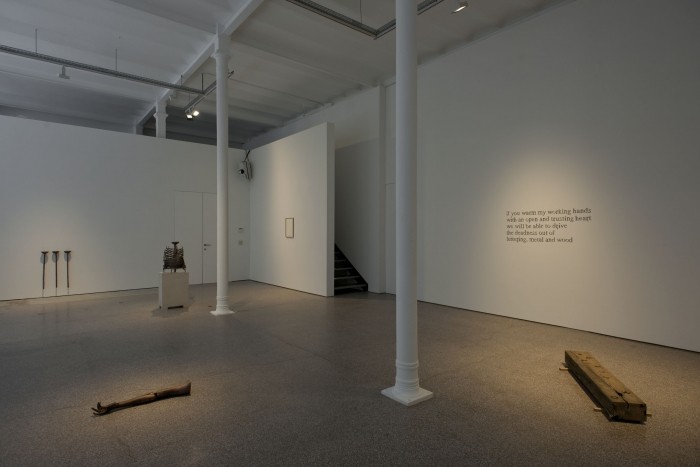Johannes Wald
16 Nov 2012 - 26 Jan 2013
JOHANNES WALD
16 November 2012 - 26 January 2013
Greta Meert Gallery presents its first solo exhibition by Johannes Wald (Sindelfingen, 1980).
Johannes Wald's sculptures do not follow the conventional notion of the art of sculpture. His work embodies the concept of sculpture; it evokes questions concerning the viewing, the contemplation and the genesis of a piece of sculpture. How can abstract notions, such as feelings, artistic qualities and ambitions, be materialised? Is form, as mimesis or expression at all possible?
The mural text in lead letters may be read as an introduction to the exhibition and may further be related to the video installation in the middle of the space. Cold veins, warm light zooms in on a male chest and registers its breathing. It makes the skin of the model and the texture of the marble coincide, and ‘breathes’ life into the stone material.
Similarly, the gallery space is filled with sculptures that have not necessarily been sculpted as such. Innocence, beauty and grace cast in bronze and Language and inconsistence to be cast in bronze contain a reference to the technique of bronze casting. The cones and channels which are normally used to lead the hot material into a casting form are a moment of transition between the meaningless material and a concrete result. Now the casting process is reduced to this moment, which precedes each form and evokes a multitude of qualities. Each cone stands for an elusive quality that is kept in a possible becoming of the sculpture.
This work is in line with a previous series of sculptures in which the artist analyses the sculptural process by elevating its artefacts, waste material and intermediary stages to the artistic status of sculpture. Studying the Greeks Grace starts from an intermediary stage, however, the projection of the plaster copies of ancient sculptures from the Abguss-Sammlung Antiker Plastik, Berlin, onto a massive marble plate brings the sculptural process to completion. Not a sculpted form in the conventional sense, we can hardly even speak of a third dimension, but like many works in the show, it is an alternative reading of a sculpture as an 'image in stone'.
Johannes Wald's work continues the conceptual tradition in which all materialisation loses its relevance, but he does not regard this moment in art history as a final point. Sculpture is possible, but its formal possibilities are being completely rethought. The result is a totally open practice in which the artist questions his medium, and by extension his artistic calling: Johannes Wald - Belgian artist (Jan Bos - Jean Forêt) is not a static given, and neither are his sculptures.
16 November 2012 - 26 January 2013
Greta Meert Gallery presents its first solo exhibition by Johannes Wald (Sindelfingen, 1980).
Johannes Wald's sculptures do not follow the conventional notion of the art of sculpture. His work embodies the concept of sculpture; it evokes questions concerning the viewing, the contemplation and the genesis of a piece of sculpture. How can abstract notions, such as feelings, artistic qualities and ambitions, be materialised? Is form, as mimesis or expression at all possible?
The mural text in lead letters may be read as an introduction to the exhibition and may further be related to the video installation in the middle of the space. Cold veins, warm light zooms in on a male chest and registers its breathing. It makes the skin of the model and the texture of the marble coincide, and ‘breathes’ life into the stone material.
Similarly, the gallery space is filled with sculptures that have not necessarily been sculpted as such. Innocence, beauty and grace cast in bronze and Language and inconsistence to be cast in bronze contain a reference to the technique of bronze casting. The cones and channels which are normally used to lead the hot material into a casting form are a moment of transition between the meaningless material and a concrete result. Now the casting process is reduced to this moment, which precedes each form and evokes a multitude of qualities. Each cone stands for an elusive quality that is kept in a possible becoming of the sculpture.
This work is in line with a previous series of sculptures in which the artist analyses the sculptural process by elevating its artefacts, waste material and intermediary stages to the artistic status of sculpture. Studying the Greeks Grace starts from an intermediary stage, however, the projection of the plaster copies of ancient sculptures from the Abguss-Sammlung Antiker Plastik, Berlin, onto a massive marble plate brings the sculptural process to completion. Not a sculpted form in the conventional sense, we can hardly even speak of a third dimension, but like many works in the show, it is an alternative reading of a sculpture as an 'image in stone'.
Johannes Wald's work continues the conceptual tradition in which all materialisation loses its relevance, but he does not regard this moment in art history as a final point. Sculpture is possible, but its formal possibilities are being completely rethought. The result is a totally open practice in which the artist questions his medium, and by extension his artistic calling: Johannes Wald - Belgian artist (Jan Bos - Jean Forêt) is not a static given, and neither are his sculptures.

